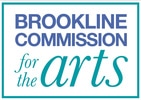On the evening of October 22, 2023, over 50 puppetry fans from Greater Boston, as well as from all over the country, joined together virtually and in-person to celebrate and learn about the work created by six spectacular Black puppetry artists of Puppet Showplace’s 2023 Creative Residency for Black Puppeteers (CRBP). This year’s cohort was led by Community Curator Tanya Nixon-Silberg and Cohort Mentor Nehprii Amenii (also an alumna of the 2020 CRBP cohort), with logistical support from Puppet Showplace’s Resident Artist Sarah Nolen.
The Creative Residency artists joined the event via Zoom, with Tanya Nixon-Silberg (right) and Sarah Nolen (left) at Puppet Showplace Theater.
“The Creative Residency for Black Puppeteers came out of me discovering and loving puppetry. I found myself in a lot of spaces where I was the only Black person — and that can be okay!” laughs Tanya, an activist and educator whose first work of puppetry, My Night in the Planetarium premiered through Puppet Showplace’s New Show Incubator. “But I found that our stories, our lives, our joys, our struggles, our voices were not very well represented in puppetry. So I went to [Puppet Showplace’s Artistic Director at the time] Roxie Myhrum, and she was really great, and said let’s come up with a Creative Residency” and the program was born.
“There were a couple of meetings with Puppet Showplace Theater, and then we started to meet in affinity, which meant that all of us Black people met together online — without the eye of the institution, but knowing that we had the backing of the institution. And that model worked really well,” says Tanya.
In four years, the CRBP has supported the work of 20 artists so far, who have gone on to win Jim Henson Foundation grants, premiere full-length shows, and more. This year’s artists come from varied creative backgrounds — some are seasoned professional puppeteers, while others come to puppetry as sculptor, storyteller, chemist, or capoeirista, all challenging themselves to expand their puppetry skill and practice.
The evening of artist talks ended with a champagne toast to the 2023 cohort, the future of their projects, and to the voices and vitality of Black artists.
The artists and their projects
“I’ve been a marionettist for years and years, but this was my first puppet build!” shared Emmanuel Elpenord (he/him) who used this residency to fabricate his first-ever marionette, “Turtle Boy,” after years of working as a professional marionettist at the Swedish Cottage Marionette Theater in NYC. As a queer, first-generation Haitian-American artist, Emmanuel is working to bring Haitian folklore to the puppet stage, saying, “my goal is to share these stories that people really have no idea about.” Emmanuel also offered a marionette jointing workshop for his fellow cohort members, which his peers cited as being integral to aiding in their own work.
Stay up to date with Emmanuel’s art through his website and Instagram!
Brenda Ray (she/her) taught us all about Aesop, the Greek storyteller famous for powerful fables. In researching her project, Brenda discovered that Aesop may in fact have been an African man held in enslavement, and may have been physically disabled, both of which may have influenced his powers as a storyteller. Brenda herself came to puppetry through storytelling, saying, “When I first started, I was a terrible storyteller, and I refused to be a terrible storyteller.” During her residency, she developed character designs and storyboards for a telling of The Lion and The Four Bulls, with a goal of creating a story that will resonate with tweens.
Stay up to date with Brenda’s art through her website and Instagram!
Water Walker by Ash Winkfield
Ash Winkfield (xe/xem/xyr) completed the residency while touring across the U.S. as a puppeteer with Little Amal — and after 10 years as a professional puppeteer, “it seems like it’s about time to start making something of my own.” Ash’s project, Water Walker is inspired by the Igbo Landing historic event in 1803, when 75 enslaved Igbo people, upon disembarking at their captor’s destination of Georgia, chose death over slavery and fatally walked into the waters of Dunbar Creek. Ash used xyr residency time to develop a design and fabrication process for the shadow puppetry elements of the show, and presented the beautiful stained glass effect to the audience. Xe was met with gasps of appreciation for xyr careful craft.
Stay up to date with Ash’s art through xyr website and Instagram!
Jordan Brown (he/they) brought us to an almost interdimensional world with the video study they created for When I See the Water. “I was researching folklore from West Africa, from the Caribbean, and the Black American South around water creatures and mermaids,” said Jordan, “but for me, the mermaid figure is a shapeshifting, fluid figure, and it’s really the story of someone journeying towards their own liberation.” Jordan’s abstraction of his themes mesh perfectly with his list of “key words relating to his practice” on his website: dream, poem, ache, brick, oily, vision, mermaid, rhythm, return, ocean, and more.
Stay up to date with Jordan’s art through their website and Instagram!
Allotropy by Ladipo Famodu
Ladipo Famodu (he/him) wasn’t sure if he was a puppeteer at the beginning of this residency — an artist, designer, chemist, capoeirista, and metalcaster, who has begun to work with durational performance and animating sculptural figures. “My approach to puppetry is a bit more experimental — I like to animate the object through use of my body, my hands, and light, rather than employing mechanical means” explained Ladipo. With his project, “Allotropy.” Ladipo uses wire “characters” to explore the intersection of chemistry, dance, and puppetry, inspired by the properties of carbon as well as capoeira, an Afro-Brazilian practice developed by enslaved people in which one can “practice for battle, while making it look like you’re playing a game or dancing. In my work I really like [to combine] playfulness and seriousness at the same time.”
Stay up to date with Ladipo’s art through his website and Instagram!
Mr Jones by James Welch
James Welch (he/him) came to puppetry through the world of visual arts, having studied sculpture and textiles. He used his residency time to develop a range of character designs including a marionette — whose design was aided by the marionette jointing workshop taught by Emmanuel — as well as flat puppets using felt, paper, and shadows for his project Mr. Jones, a stop motion multimedia story of a man who becomes trapped in an airport while on a quest toward self-expression. James aims to “challenge the prevailing narrative of suffering associated with Black existence,” and finds that creative community is essential to his practice. His design for Mr. Jones includes a puppet stage inside of a suitcase, and the tiny scale and close camera work creates a sense of intimacy that fits this intimate story in which, as Welch says with laugh, “I am Mr. Jones; Mr. Jones is me.”
Stay up to date with James’s art through his website and Instagram!
Gratitude
This program would not be possible without support from all of our donors, past and present, who make it possible for our small theater to invest in artists. These include Cheryl Henson and the Henson Foundation, the Marc Dunworth Foundation for the Performing Arts, the Calgary Animated Objects Society, the Bob Jolly Charitable Trust, and puppet companies Great Small Works and Brzezinski & Schap, who helped crowdsource donations to launch the original iteration of the residency.
What’s next?
Artists interested in applying for future cohorts can sign up for updates on the CRBP!
Supporters who wish to ensure the future of the Creative Residency can make a contribution here, or contact artistic@puppetshowplace.org.














